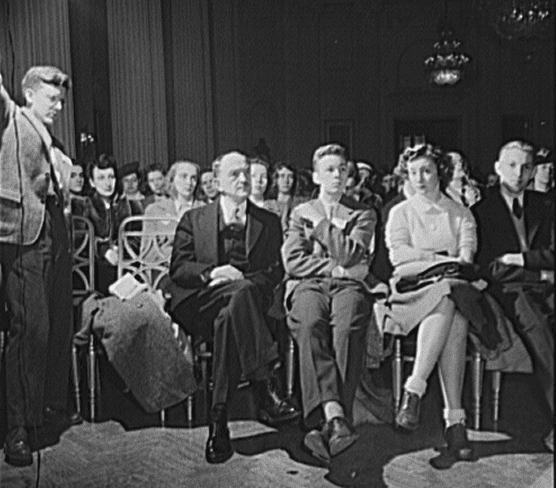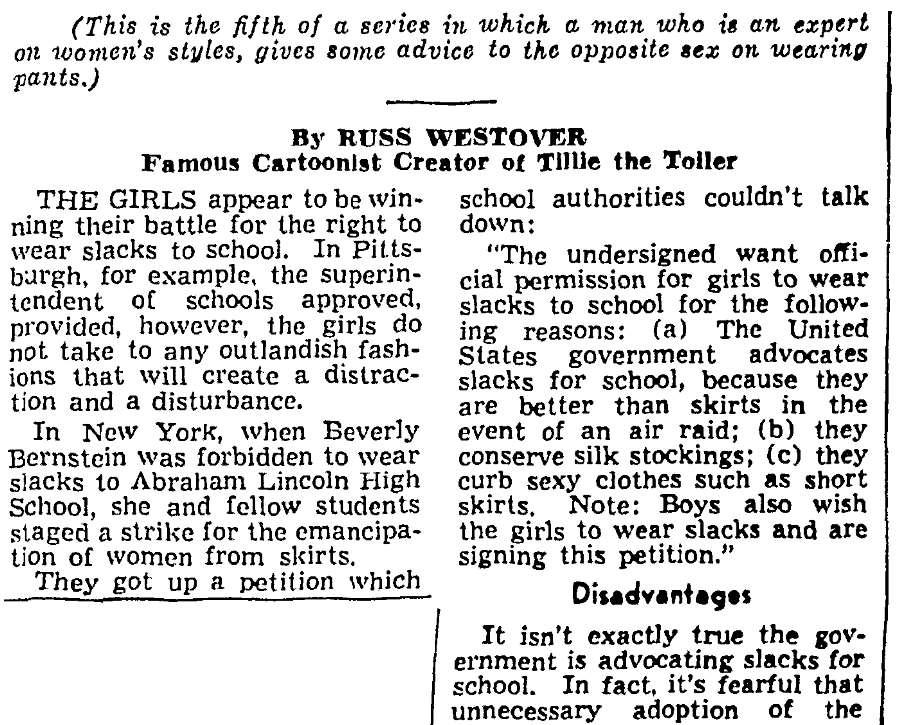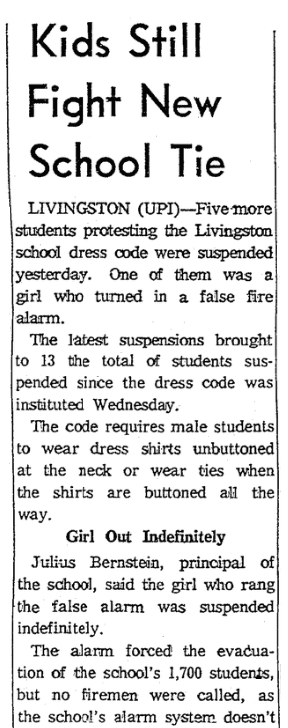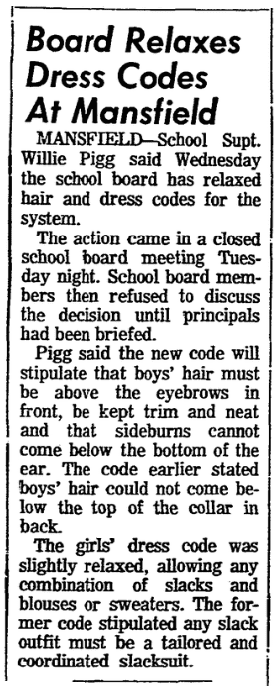Introduction: In this article, Gena Philibert-Ortega searches old newspapers to learn more about high school dress codes from the past. Gena is a genealogist and author of the book “From the Family Kitchen.”
It’s time to go back to school! Most students across the United States have either started the school year or will shortly. The lazy, carefree days of summer have evolved into that time of the year when rules and order reign supreme (or at least that’s the hope). By the time a student reaches the high school classroom, rules regarding conduct have become second nature, including the high school dress code.

My youngest is now a senior in high school and his school’s dress code has, in the past, been criticized nationally for its treatment of female students. However, this year the dress code has become more relaxed in dictating what students are allowed and not allowed to wear. Dress codes and criticisms of those codes by students, teachers, and parents are decades old. In researching those codes, it becomes apparent that some rules, like the length of a girl’s skirt, remain consistent while others, like the length of a boy’s hair, might be in response to the fashion trends of a generation.
Girls’ Dress Code: Skirts vs Pants
One prominent theme in dress codes for female students up until the 1970s (and sometimes even later depending on the school) was the prohibition against wearing pants. Judging from the comments I received from Facebook friends on this topic, female students were required to wear skirts or dresses well into the 1970s. And the appropriate length – at the knees – was judged by having the girl kneel so that her skirt would hit the floor. Girls were required to wear skirts at school no matter how cold the weather was.
The penalty for not obeying the dress code? Depending on the school it could be either sending the student home to change, detention, or suspension – as one Facebook friend was when she wore a polyester pantsuit that looked a little too much like denim, resulting in a two-day suspension in the mid-1970s. Even when female students could finally wear pants at school, they were not free to choose any pair of pants. For many it had to be a coordinated pantsuit and absolutely not denim jeans.
Did anyone ever publicly protest their school dress code? No doubt some students did. There was one case in 1942 when Abraham Lincoln High School (Brooklyn, New York) student Beverly Bernstein protested her school’s dress code by wearing slacks and a sweater to school one day. She was promptly suspended, which resulted in other girls carrying on with the protest the next day and wearing slacks in solidarity.
Cartoonist Russ Westover of “Tillie the Toiler” fame weighed in with his opinions about women wearing slacks, and mentioned Beverly’s case. According to his article the girls had put together a petition for school authorities that cited the government’s advocating for wearing slacks in the “event of an air raid” and that wearing slacks “conserved silk stockings,” which reflected the WWII-era they were living in.


Skirt lengths have always been an issue addressed in dress codes. While it follows that short skirts would largely be frowned upon, I was surprised when Facebook friends told me that they were sent home in the 1960s and 1970s for skirts that reached their ankles!
The reason might be found in this newspaper article from 1965. A principal justified sending two girls home for wearing ankle-length dresses because: “The attire worn by a student must not be unorthodox in such a manner as to be a distracting or disturbing factor in the instruction program.” Apparently, some schools believed that long skirts were just as distracting as short ones.

Boys’ Dress Code: Ties and Haircuts
Boys’ dress codes were also controversial in decades past. While jeans and t-shirts are the norm today, in 1958 the dress code in Livingston, New Jersey, required boys to wear “dress shirts unbuttoned at the neck or wear ties when the shirts are buttoned all the way.” It seems the kids at that high school were not happy about the new dress code; 13 had already been suspended for protesting it in less than a week. A friend from Kansas told me that his school in the 1960s required the same standard of dress as above, but the shirt had to be tucked in and a belt worn at all times. Dressing casually was not an option when one went to school.

One of the concerns addressed in boys’ dress codes was the length and style of their hair, as in the case of the following 1972 announcement from Fort Worth, Texas, that stated boys’ hair: “Must be above the eyebrows in front, be kept trim and neat and that sideburns cannot come below the bottom of the ear.” This had been changed from the previous rule that “boys’ hair could not come below the top of the collar in the back.” There’s no doubt that this most likely became an issue as men’s hairstyles followed trends found in the music world of the 1960s and 1970s.

Now It’s Your Turn
What was the dress code when you were a teenager? How has it changed from that time to today? What dress code do your kids or grandkids have to follow? Did you rebel against the dress code?
Note: Special thanks to my Facebook friends who shared their stories with me about their high school dress codes. There are too many to name individually but their stories helped me with the research for this article.

When I was in high school in the mid-70s we were required to wear dresses that could not be more than two inches above the knee. I remember a new girl showing up to class in a micro-mini with matching underpants and really tall platform shoes. Daring! She wasn’t sent home, but must have been called to the office because she never wore it again. I never publicly protested the dress code, but did heavily lobby my father who was on the school board to allow us to wear pants. We had long winters and there were many days I arrived at school when the temps were below freezing. My father was eventually successful in getting the rule changed. After that almost all the girls wore what the boys did — jeans and t-shirts. The boys, of course, had no dress code. It was my first realization that women’s bodies are viewed as public property. It’s unfortunately an ongoing battle.
Thank you so much for sharing this story. How lucky you were to have your father on the school board. Wearing pants in cold weather (or really at school in whatever the weather) seems obvious to me so I’ve been amazed that young women have had to fight for that right for so long.
Thank you for taking the time to comment on my article.–Gena
While I’m a male, I know that in cold weather (I come from Minnesota) girls could wear slacks UNDER their skirts or dresses to and from school, but they had to change as soon as they got to school in the restroom, and if they wanted the slacks on for their trip home they would have to put them on after school. This was in the 1950s and 1960s.
George,
Absolutely. I had a few women tell me that wearing slacks under their skirts was allowed as they traveled to and from school as you commented. Maybe that was the start of allowing girls to wear slacks and later jeans to school.
Thanks for taking time to comment. I appreciate it.–Gena
K-12 girls had to wear skirts that would touch the floor if we knelt down.
It could be blizzard conditions and below zero and the skirts were still required.
Boys had to have hair that did not touch the neck. My brother got sent home monthly for a hair cut. Boys had to wear wash slacks and no blue jeans — they could “scratch the desks.”
My first teaching job, this was about the same.
Then I moved to the Boston area and the first day of school the boys arrived in shirts and ties!!! The vice principal spent a lot of time trying to keep those shirts tucked in and you can imagine how well junior high boys were at that all day! I asked if that was for the first day and was told no — this is the dress code!
Erica, I love the comment that blue jeans would scratch the desks. Thanks for sharing this!–Gena
The subject of old dress codes came up with my siblings just a few weeks ago. They had gone to high school with a cousin who was considered “wild.” One day, the cousin came to school wearing a very short skirt. A teacher made her kneel, and the skirt was still several inches above the knee. The cousin was sent home, and the thought of this still tickles my siblings.
Jennifer,
Thanks for sharing that story. It is interesting how that experience of school dress codes is something still remembered by adults decades after graduating.
Thank you for taking the time to comment. I appreciate it!
Erica my Catholic school in the Bronx also had that rule that skirts must touch the floor. I was so young but remember vividly the two rebellious girls who shortened their skirts, and were made to kneel on rice the entire school day! Later moving to NJ, I was in middle school when the girls were finally permitted to wear pants, in the late 60’s – Probably to quell the mini skirt fad!
Wow Cathy! I can’t even imagine being forced to kneel on rice. So I’m curious what happened to boys who disobeyed the dress code?
Thanks for sharing your story.–Gena
I went to a Catholic girls high school in Philadelphia. Obviously, no boys there. Our uniforms had to be 2 inches below our knees. You had to be able to kneel with the skirt touching the floor. We did a lot of kneeling in those days.
Mary, It’s interesting that even in an all-girls school you still had to wear a skirt that passed your knees. Thanks for sharing that!
High school 1960-64. I was undaunted by the “length of skirt” rule for our school: skirt had to reach the floor when kneeling. My skirts were the correct length, but I would roll them up a few times at the waist, so they were above my knee. If staff noticed, I’d be sent to the office (unrolling my skirt on the way). I would kneel and my skirt would reach the floor, passing the test. As soon as I was out of the office, I’d roll it back up.
Diane,
A true rebel! I love that story! Thank you so much for sharing it.–Gena
Yep, me too!
Very gucci gang
When we moved from the valley to a small (3 classes – 1st thru 8th grade) mountain school, my mother asked about the dress code as she saw girls in pants. Two teachers looked at each other, smiled, and said “No bikinis!”
Great story Sue! Thanks for sharing that!
Hi! This is an interesting article. When I was a girl in school in Winston-Salem, NC, back in the early 50s, we were not allowed to wear pants, unless it was very cold, and then only under our skirts. We had to take them off in the coat room and leave them with our coats, and put them back on when we went home. On those really cold days, we did not go outside for recess.
In the late 50s and early 60s, when I was in high school in Blacksburg, VA, we were not allowed to wear sundresses with spaghetti straps, mini-skirts above 2″ above the knees, shorts, tee shirts, etc.
Cheryl,
Interestingly enough, until last year spaghetti straps were not allowed at my local high school. So in some cases these dress codes haven’t changed.
Thank you so much for sharing your experience.
Natrona County High School (NCHS) in Casper, WY, required “uniforms” into the early 70s. Girls were required to wear straight or box pleated skirts in black or navy blue only, hems had to touch the floor when you were asked to kneel. A white tailored blouse (well ironed) was required, but you could wear a classic (no embellishment) cardigan over the blouse as long as the collar was outside. Sweaters could be in any color, so we spiced things up with bright colored sweaters and matching shoes! Boys could wear jeans, but they had to be clean and pressed. Shirts with collars were required and had to be tucked in and a belt worn. Length was not an issue since many boys wore them short with white socks and loafers.
I was always told that the reason everyone had to wear uniforms was because NCHS was the only high school in the county and due to the big disparity between the rich oil millionaires and the rest of the population, we all felt more like equals. (Didn’t work, the rich kids still stuck out.)
Linda, that’s an interesting reason for having a dress code and obviously it didn’t achieve what the adults thought it would.
Thank you for taking the time to share your story.
When my daughter was in high school, she was not able to wear slacks. She is extremely tall and at the time in the 70s the skirts were short. She pleaded with me to let her wear slacks so her legs would be covered. We bought her several slacks outfits that were modest and she wore them to school. Shortly after that, girls were generally allowed to wear slacks. Her outfits were modest and she felt so much better about reaching up into her locker without exposing her underwear!
Jeanette,
That’s a good point that depending on the time period and the fashion, some clothes may be impractical for school. Other readers have previously commented on the cold weather and wearing skirts. Reaching for a locker is another time when wearing pants is more practical.
Thanks for taking the time to comment.
Gena
Grades 1-8 we lived close to school, so we walked to/from school AND home for lunch (1 hour allowed). In cold/snowy weather, we girls wore slacks UNDER our dresses & skirts, never slacks or jeans, even when got to junior high & high grades. We weren’t embarrassed to dress for winter warmth, either.
Marilyn,
So did you remove the slacks once you arrived at school? That seems to be the experience of most of our readers who have commented.
Thanks for sharing your experience.
Gena
My wife, Polly, attended high school in Warrenton, VA, 1960-1963. She said if a teacher thought your skirt was too short, you were to kneel on the floor, if your skirt touched the floor you were okay – if not, home you went.
Gene,
Your wife’s experience sounds like one shared by the majority of female students before and during that time period. Thanks for sharing that!
It’s interesting to read about the high school codes. I was in high school in the 40s, and the girls just wore skirts (knee length) and blouses or “sloppy joes” (long sweaters). Boys in regulars slacks and shirts and sweaters. Jeans were just getting started, but for after school. Our shoes were polished (no sneakers, they were for gym). But when I started grammar school, first graders had strict rules. Boys wore shirts and ties, knickers or long pants. If a boy forgot his tie, he had to wear a bright green one supplied by the teacher. Hair was to be combed. Girls had to have a handkerchief pinned to their dress (not easy to get off if should you need it). Nails were inspected each morning. I’m glad my grandkids can wear what they want.
Elsa,
School has sure changed, hasn’t it? The handkerchief is an interesting addition. Thanks for sharing your experience. I appreciate it!
One reason for uniforms when I was a youth in the 50s and 60s was identity. We knew the uniforms of the various schools around. If a child was in a neighborhood/store/etc. wearing a uniform not common there, several people would politely ask if they were with their parents/needed help/etc. Uniforms were quick identification for a missing child.
Yes I had many of the “rules” above but this is the one that I trusted and the reason I support uniforms. Jeepers, nearly every job I’ve had required a uniform of some kind for identification.
Cathy,
Thanks for that perspective. That’s a good point that a child with a uniform out of the area would look out of place.
I appreciate you taking them time to comment–Gena
Going to middle school in NC in the 90s, we had the fingertip rule: all skirts, dresses, and shorts had to touch your longest finger when your hands were by your side. The babydoll tops with leggings were really popular around this time and I remember a girl getting sent to the office by the meanest teacher at the school (literally the only teacher I have had K-12th grade I couldn’t stand) because her top didn’t reach her finger. She tried to explain that she was wearing pants and the teacher said they were tights. lol, kind of funny in retrospect.
I am from California and the rules are much more lax here and I think they are even worse now. We had the fingertip rule and could wear sleeveless shirts (like men’s shirts but no sleeves) but no shirts with straps (spaghetti, tank tops, etc.) I saw a girl walking home from the high school the other day practically wearing daisy dukes. I wouldn’t have been let out of the house by my mother dressed like that! I tended to be more conservative and liked wearing skirts. I remember a girl asking me why I dressed up for school and I said because I am allowed to wear what I want and I like skirts! lol